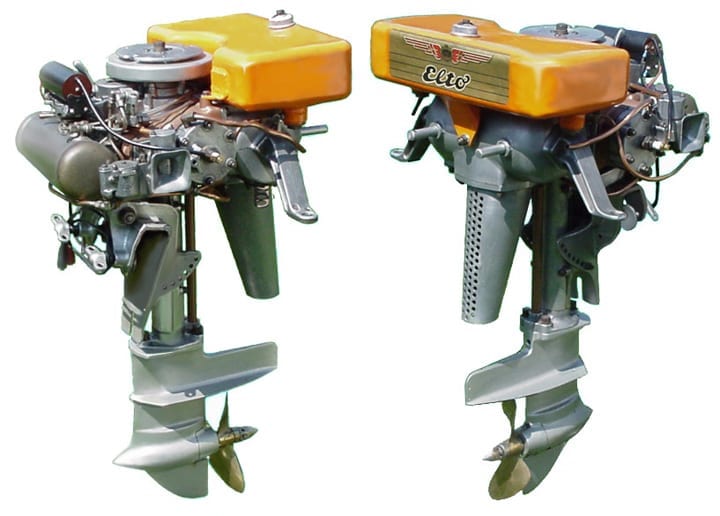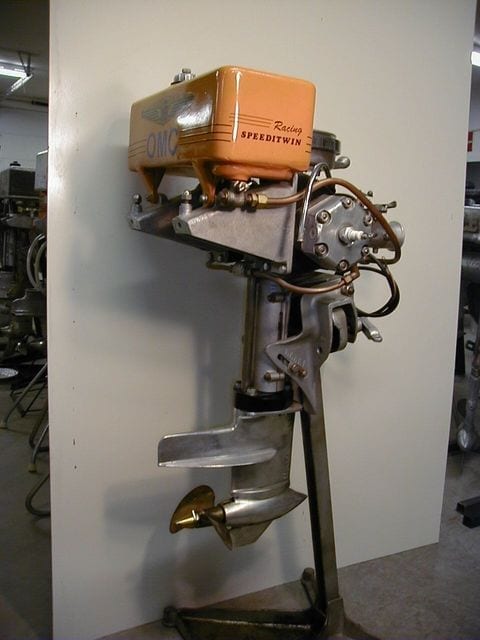Home › Forum › Ask A Member › 1930 Evinrude Speedibee
- This topic has 24 replies, 16 voices, and was last updated 5 years, 11 months ago by
 labrador-guy.
labrador-guy.
-
AuthorPosts
-
December 3, 2019 at 10:32 pm #188540
I was reading a 2000 issue of the “Outboarder” and found mention of
a “Rare OMC Speedibee”.
I had never heard of one. An Internet search found an old auction listing
where one sold, and said this about it…..
===================================
#136
Rare 1930 Evinrude 177 Speedibee outboard motor – 2 carbs – #0121
(owners note – sold during Depression, less than 10 known to exist)
=====================================On the Evinrude “Model List”, the 1930 model 177 is designated as a “Racing” model
with no horsepower listed.
http://www.yankeeaomci.org/evinrudeat100.htmWhere are the other 9 Speedibee’s hiding? 🙂
Prepare to be boarded!
December 4, 2019 at 8:08 am #188564The 177 was a Speeditwin racer not the Speedibee. There were quite a few 177 models made compared to the Speedibee racer. The Speedibee was a very unique motor. I don’t believe it’s even listed in the in the back of the “Old OUTBOARDER.
December 4, 2019 at 10:11 am #188570This is the web site that listed the motor as a “177”.
https://corycraig.hibid.com/lot/52227314/evinrude/
Is this photo a Speedibee?
Did the Speedibee have a model number?
Any photos out there of one?
Did they say Speedibee on the decal?Prepare to be boarded!
December 4, 2019 at 11:15 am #188581December 4, 2019 at 4:51 pm #188596Buc, the motor in the auction looks like a model U speeditwin racing motor, minus the foot.
The Speedibee you ask about was a class B motor, I don’t know horsepower.-
This reply was modified 5 years, 11 months ago by
 squierka39.
squierka39.
December 4, 2019 at 6:31 pm #188603Thanks guys! I wouldn’t mind finding any of those under the Christmas tree!
Prepare to be boarded!
December 4, 2019 at 9:09 pm #188608I want one.
Either one.
Both!
Bee-a-yew-tee-full!
But I’ll settle for classic 25 horse Buc.
Ha!
GJMGP
December 4, 2019 at 10:48 pm #188611They hurt my back just looking at the photos.
December 4, 2019 at 11:39 pm #188614I’d love to show up at my local boat ramp with one of those clamped to the transom!
Bob
1937 Champion D2C Deluxe Lite Twin
1954 Johnson CD-11
1955 Johnson QD-16
1957 Evinrude Fastwin 18
1957 Evinrude 3022
1958 Johnson QD-19
1958 Johnson FD-12
1959 Johnson QD-20“Every 20 minute job is only a broken bolt away from a 3-day project.”
"Every time you remove a broken or seized bolt an angel gets his wings."December 5, 2019 at 1:40 am #188616I have tried to reply 4 times now –
The SpeediBee was going to be Lockwood’s ultimate Chief. It was Finn T. Irgens baby. However Lockwood did not have the money to invest in such a radical departure from service motor norms and made the sale to Steve Briggs more attractive. Finn T. Irgens (Known to all as “Irgie”) had been corresponding with German motorcycle engineers who were the first to put roller bearings on the connecting rods. Lockwood, Elto, Johnson and Evinrude quickly followed suite. The Germans were at that time experimenting with Loop Charging, and when Evinrude gave the go ahead, the first three Speedibee prototypes were loop charged. Irgie’s main idea was to make the crankcase as tight as possible. Using one piece connecting rods eliminated the space needed to clear the connecting rod bolts. This resulted in a five piece crankshaft. The first prototype placed the full time rotary valve on the high cylinders (Starboard) front bypass port. It was found the port cylinder starved for fuel and on examination cracks were found in the alignment key slots in the crankshaft. A second rotary valve and carburetor was added to the port cylinder and the alignment keys were eliminated. In testing to failure the horsepower curve was almost a straight line. Culminating in a reading of 38 horsepower at over 8000 RPM when the engine blew up. For the third prototype a muffler was designed to limit top RPM to 6000. Top horse power was 29 at 5000 RPM. Dad pointed out the first thing a new owner would do was drill holes in the muffler. All this time costs were skyrocketing, and a switch was made to cross flow pistons for dependability. Irgie wrote a paper for the SAE (Society of Automotive Engineers) stating Loop charging was impractical for outboard motors. The fourth Prototype resulted in adding an auxiliary oiler and final proof of concept proved reliability and, at 28 put out more horse power than the Racing Speeditwin’s 26 at that time.
spell checker drives me crazy – more later
-
This reply was modified 5 years, 11 months ago by
 garry-in-michigan.
garry-in-michigan.
-
This reply was modified 5 years, 11 months ago by
-
AuthorPosts
- You must be logged in to reply to this topic.



